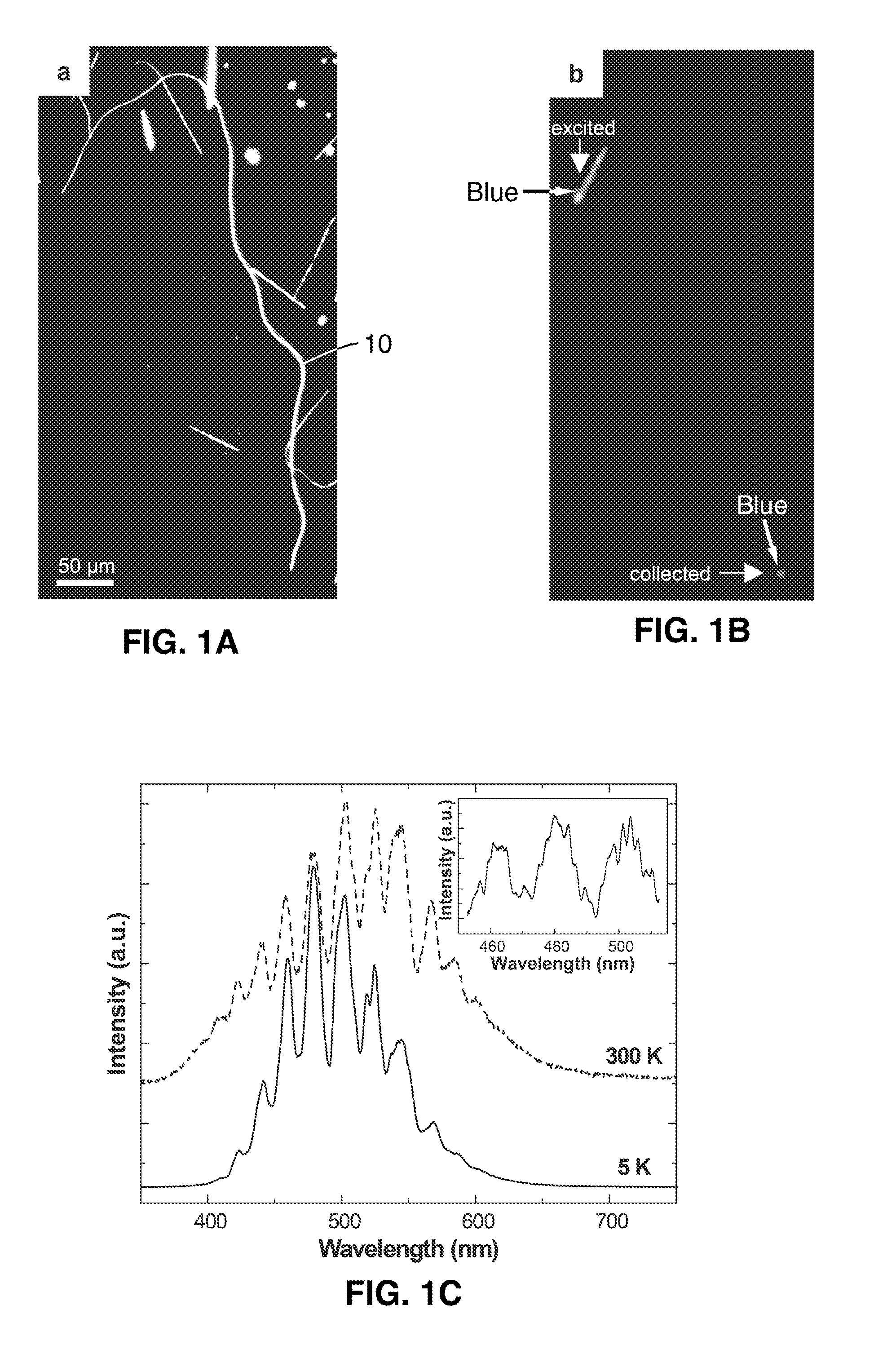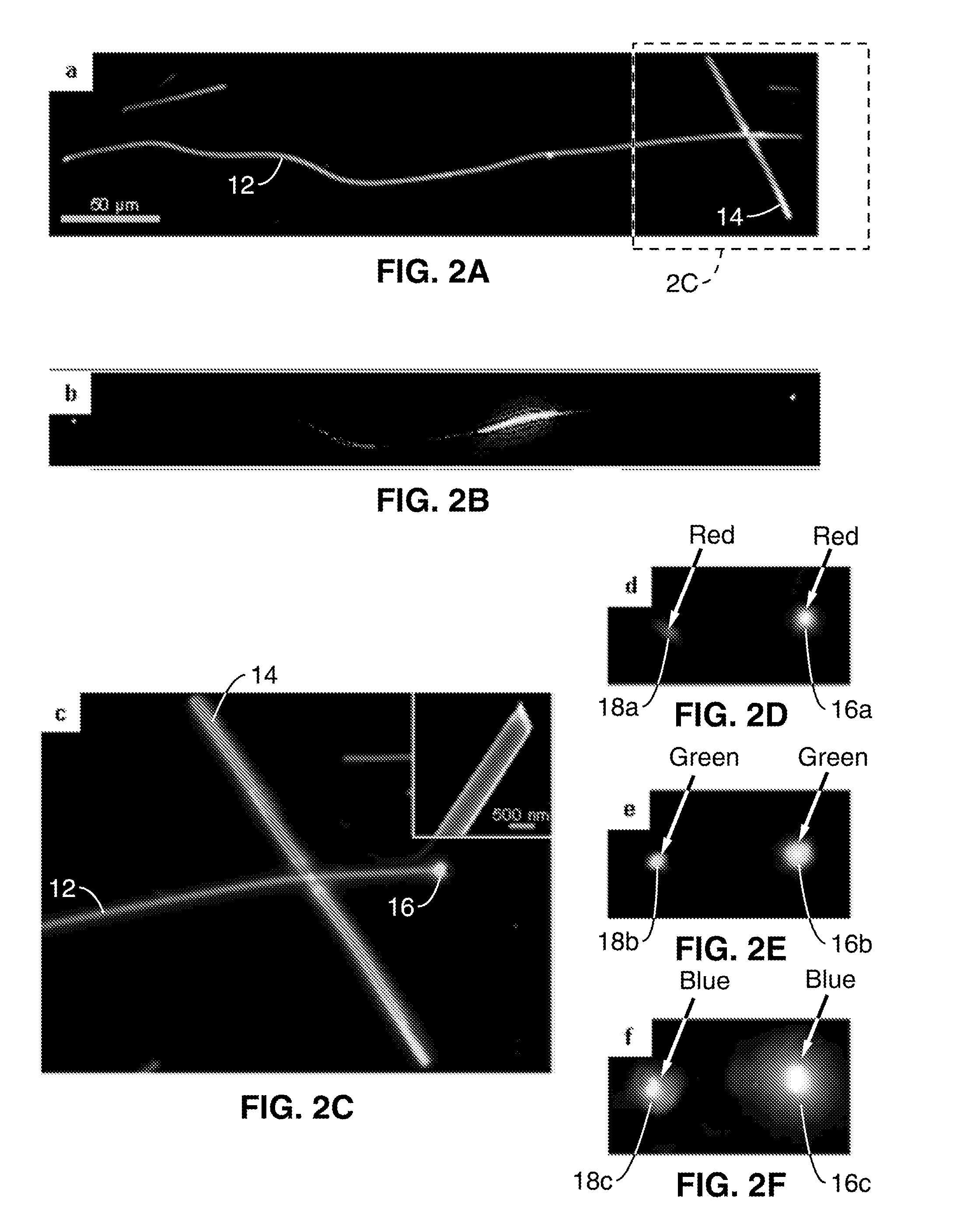Nanowires and nanoribbons as subwavelength optical waveguides and their use as components in photonic circuits and devices
a technology of nanowires and nanoribbons, applied in the field of optical waveguides, can solve the problems of unexplored optical integration, difficult and costly lithographic processes, and the assembly itself remains a major challenge, and achieve the effect of new and versatile photonic circuitry
- Summary
- Abstract
- Description
- Claims
- Application Information
AI Technical Summary
Benefits of technology
Problems solved by technology
Method used
Image
Examples
example 3
[0129] SnO2 nanoribbons were synthesized by the chemical vapor transport of SnO at 1100° C. in flowing argon. ZnO nanowires were grown as epitaxial arrays on sapphire substrates by the oxidation of metallic zinc at 800° C., using gold as a catalyst. GaN nanowires were made by the chemical vapor transport of gallium in a NH3 / H2 mixture at 900° C., with nickel as the catalyst. The SnO2 nanoribbons were dry transferred en masse to oxidized silicon substrates (600 nm SiO2, Silicon Sense Inc.). A triple-axis micromanipulator tipped with a tungsten probe (˜400 nm tip diameter) was used to remove individual ZnO and GaN nanowires (chosen by their PL spectra) from their growth substrates and then deposit them with the nanoribbons.
example 4
[0130] Nanoribbons and nanowires were manipulated with the probe under a dark-field microscope. A HeCd laser provided continuous wave (CW) resonant illumination (325 nm), while the fourth-harmonic of a Nd:YAG laser (266 nm, 8 nm, 10 Hz) was used for pulsed pumping. Laser diodes (652 nm and 532 nm) and the HeCd laser (442 nm) supplied visible light for the filtering and fluorescence demonstrations. The lasers were focused to a beam diameter of approximately 50 μm, giving a CW power density of approximately 175 W / cm2 and a pulsed energy density of approximately 10 μJ / cm2. Spectra were acquired with a fiber-coupled spectrometer (gratings at 150 and 1200 grooves / mm, SpectraPro 300i, Roper Scientific) and liquid N2-cooled CCD setup. Black-and-white and color images were recorded with two microscope-mounted CCD cameras (CoolSnap fx and CoolSnap cf, Photometrics).
[0131] Many of the nanoribbons / wires described herein operated as single-mode fibers for some of the experimental wavelengths, ...
example 1
[0157] Tin dioxide (SnO2) nanoribbons were synthesized through a chemical vapor transport process. An alumina boat filled with tin monoxide powder was heated (1100° C.) in an alumina tube under a continuous flow of argon (300 torr) for ˜2 hours. After removing the boat from the tube furnace, the nanoribbons were deposited on a clean glass substrate for optical characterization (see below). For surface enhanced Raman spectroscopy (SERS) detection, silver nanocrystals were prepared using a modified polyol process in which silver nitrate is reduced in a solution of 1,5-pentanediol (˜190° C.) in the presence of a capping polymer.
[0158] All experiments were performed with an upright dark-field microscope operating in reflection mode. Monochromatic laser light was focused onto the sample at a 35° angle normal to the substrate. Broadband light (FWHM>200 nm) was generated in the waveguide by exciting the SnO2 nanoribbon with the 325 nm line of a continuous-wave HeCd laser (Melles Griot, Ir...
PUM
 Login to View More
Login to View More Abstract
Description
Claims
Application Information
 Login to View More
Login to View More - R&D
- Intellectual Property
- Life Sciences
- Materials
- Tech Scout
- Unparalleled Data Quality
- Higher Quality Content
- 60% Fewer Hallucinations
Browse by: Latest US Patents, China's latest patents, Technical Efficacy Thesaurus, Application Domain, Technology Topic, Popular Technical Reports.
© 2025 PatSnap. All rights reserved.Legal|Privacy policy|Modern Slavery Act Transparency Statement|Sitemap|About US| Contact US: help@patsnap.com



